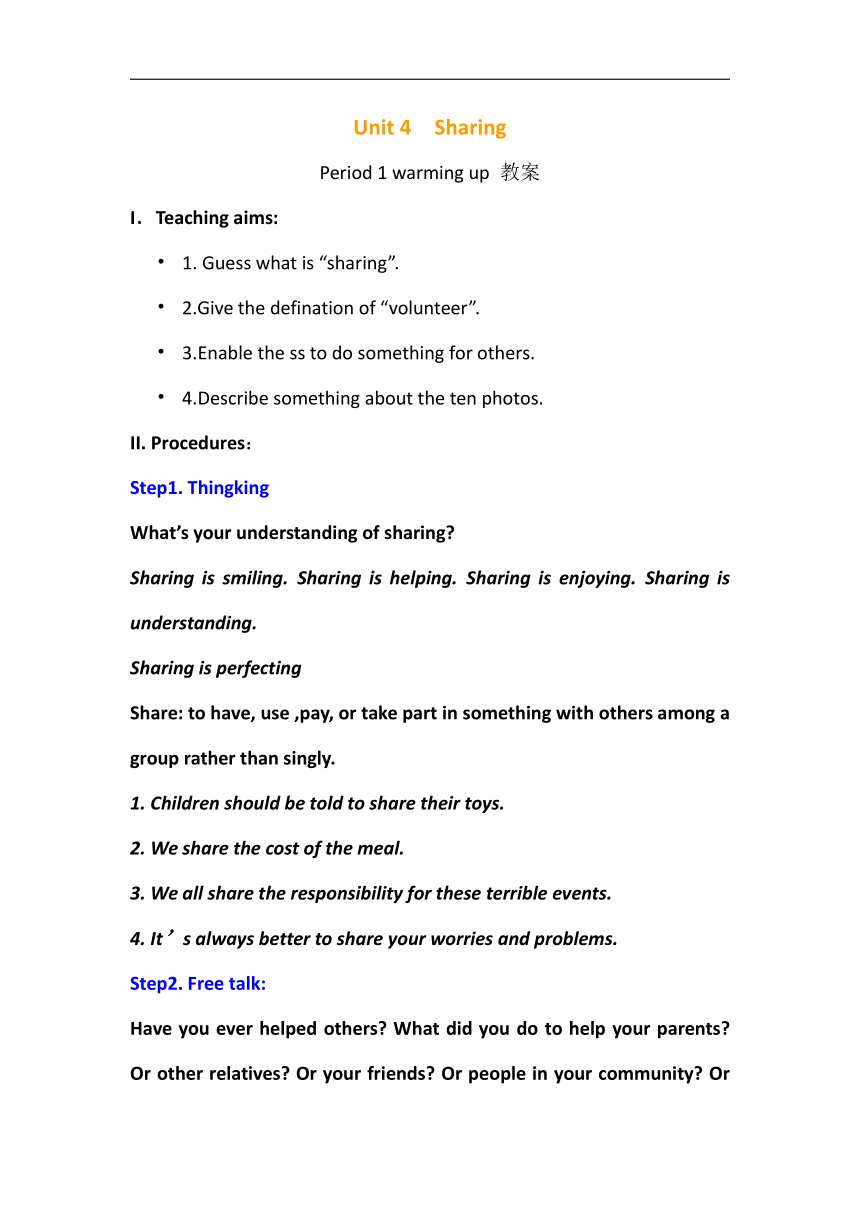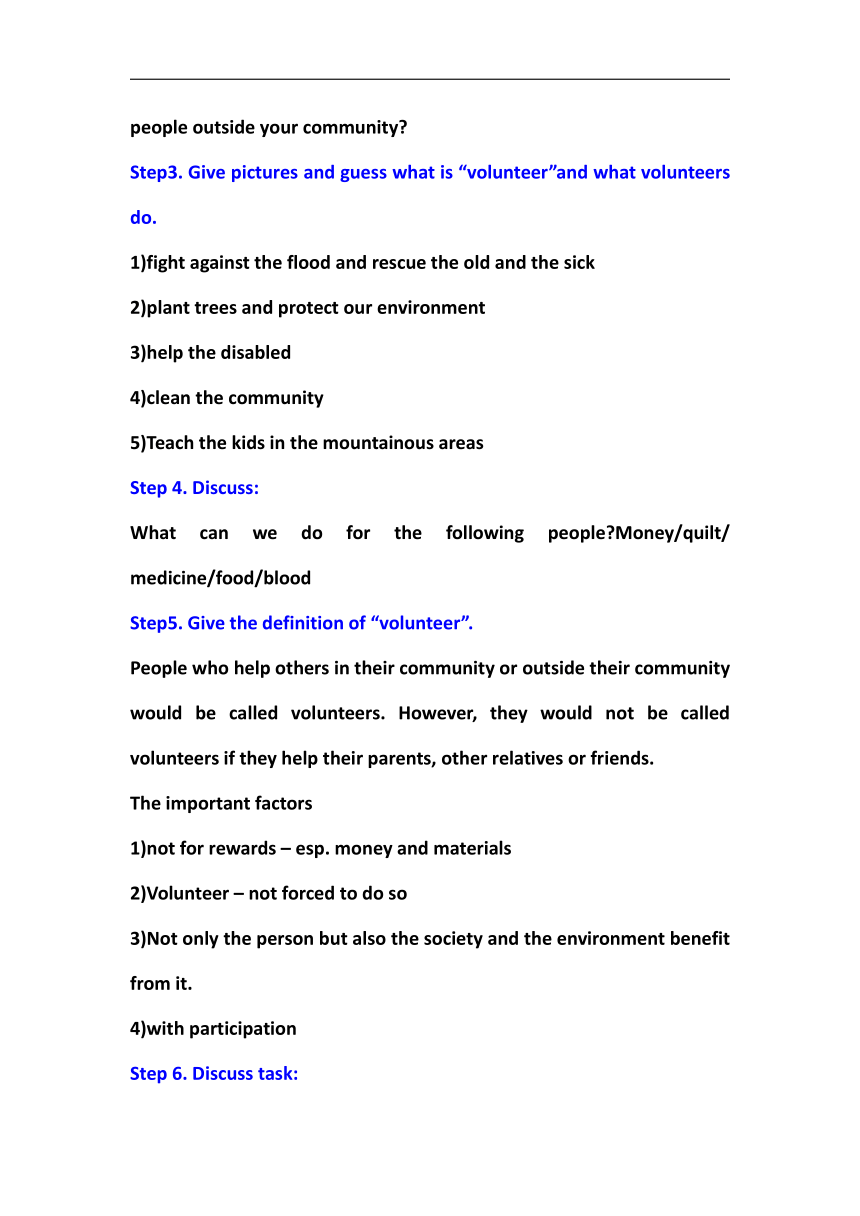人教新课标高二英语选修七 Unit4 Sharing warming up教案
文档属性
| 名称 | 人教新课标高二英语选修七 Unit4 Sharing warming up教案 |  | |
| 格式 | zip | ||
| 文件大小 | 12.6KB | ||
| 资源类型 | 教案 | ||
| 版本资源 | 人教版(新课程标准) | ||
| 科目 | 英语 | ||
| 更新时间 | 2019-10-16 11:14:08 | ||
图片预览


文档简介
Unit 4 Sharing
Period 1 warming up 教案
I.Teaching aims:
1. Guess what is “sharing”.
2.Give the defination of “volunteer”.
3.Enable the ss to do something for others.
4.Describe something about the ten photos.
II. Procedures:
Step1. Thingking
What’s your understanding of sharing?
Sharing is smiling. Sharing is helping. Sharing is enjoying. Sharing is understanding.
Sharing is perfecting
Share: to have, use ,pay, or take part in something with others among a group rather than singly.
1. Children should be told to share their toys.
2. We share the cost of the meal.
3. We all share the responsibility for these terrible events.
4. It’s always better to share your worries and problems.
Step2. Free talk:
Have you ever helped others? What did you do to help your parents? Or other relatives? Or your friends? Or people in your community? Or people outside your community?
Step3. Give pictures and guess what is “volunteer”and what volunteers do.
1)fight against the flood and rescue the old and the sick
2)plant trees and protect our environment
3)help the disabled
4)clean the community
5)Teach the kids in the mountainous areas
Step 4. Discuss:
What can we do for the following people?Money/quilt/ medicine/food/blood
Step5. Give the definition of “volunteer”.
People who help others in their community or outside their community would be called volunteers. However, they would not be called volunteers if they help their parents, other relatives or friends.
The important factors
1)not for rewards – esp. money and materials
2)Volunteer – not forced to do so
3)Not only the person but also the society and the environment benefit from it.
4)with participation
Step 6. Discuss task:
What voluntary work have you done? If not, what will you volunteer to do in the future?
Which countries do you think need help most? Why?
In which country do you want to do voluntary work? In China or abroad? Why?
Step7. Pre-reading(to learn something about Papua New Guinea)
What do you know about Papua New Guinea?
There are many volunteers working in different mountainous areas or developing countries, among which Papua New Guinea(PNG) is one.
Location: situated to the north of Australia
Population: about 5.7 million
Language: English as the official language
Pidgin English as the language for communication
Economy: a poor country with most people living in tribal villages and depending on subsistence farming to make a living.
Education: About 85% of children start school but only about 60% of these reach Year 5
Step8. Give a brief description of the photos:
Jo was a volunteer worked in Papua New Guinea (PNG) for two years.
The following photos were taken by Jo in PNG. Look at the photos and answer the questions.
Photos 1---3
1.What kind of student was in Jo’s class? Poorly dressed teenage boys
2.Describe the classrooms.
wooden pools, bamboo walls, grass roofs, grass on the floor, no glass in the windows
3. What similarities and differences can you find between Jo’s and yours?
Similarities: In a room with groups
differences: Jo’s classroom made of bamboo with grass roof and no windows
Ours made of bricks with glass windows
Photos 4---10
1.What can you say about the village?
The village is small. It’s by a river at the bottom of a valley. It has steep slopes all around it.
2.What can you say about life in the village?
The village huts are small. They have no widows and are made of wood, bamboo, and grass. The main crop is peanuts. The tool for planting is a digging stick. There is a bare-footed woman carrying a naked baby and a heavy bag on her shoulders.
Step9. Homework:
Ask Ss to work in groups and talk about the donations. If possible, encourage them to do for the poor children in poor areas in our country or in other countries.
Period 1 warming up 教案
I.Teaching aims:
1. Guess what is “sharing”.
2.Give the defination of “volunteer”.
3.Enable the ss to do something for others.
4.Describe something about the ten photos.
II. Procedures:
Step1. Thingking
What’s your understanding of sharing?
Sharing is smiling. Sharing is helping. Sharing is enjoying. Sharing is understanding.
Sharing is perfecting
Share: to have, use ,pay, or take part in something with others among a group rather than singly.
1. Children should be told to share their toys.
2. We share the cost of the meal.
3. We all share the responsibility for these terrible events.
4. It’s always better to share your worries and problems.
Step2. Free talk:
Have you ever helped others? What did you do to help your parents? Or other relatives? Or your friends? Or people in your community? Or people outside your community?
Step3. Give pictures and guess what is “volunteer”and what volunteers do.
1)fight against the flood and rescue the old and the sick
2)plant trees and protect our environment
3)help the disabled
4)clean the community
5)Teach the kids in the mountainous areas
Step 4. Discuss:
What can we do for the following people?Money/quilt/ medicine/food/blood
Step5. Give the definition of “volunteer”.
People who help others in their community or outside their community would be called volunteers. However, they would not be called volunteers if they help their parents, other relatives or friends.
The important factors
1)not for rewards – esp. money and materials
2)Volunteer – not forced to do so
3)Not only the person but also the society and the environment benefit from it.
4)with participation
Step 6. Discuss task:
What voluntary work have you done? If not, what will you volunteer to do in the future?
Which countries do you think need help most? Why?
In which country do you want to do voluntary work? In China or abroad? Why?
Step7. Pre-reading(to learn something about Papua New Guinea)
What do you know about Papua New Guinea?
There are many volunteers working in different mountainous areas or developing countries, among which Papua New Guinea(PNG) is one.
Location: situated to the north of Australia
Population: about 5.7 million
Language: English as the official language
Pidgin English as the language for communication
Economy: a poor country with most people living in tribal villages and depending on subsistence farming to make a living.
Education: About 85% of children start school but only about 60% of these reach Year 5
Step8. Give a brief description of the photos:
Jo was a volunteer worked in Papua New Guinea (PNG) for two years.
The following photos were taken by Jo in PNG. Look at the photos and answer the questions.
Photos 1---3
1.What kind of student was in Jo’s class? Poorly dressed teenage boys
2.Describe the classrooms.
wooden pools, bamboo walls, grass roofs, grass on the floor, no glass in the windows
3. What similarities and differences can you find between Jo’s and yours?
Similarities: In a room with groups
differences: Jo’s classroom made of bamboo with grass roof and no windows
Ours made of bricks with glass windows
Photos 4---10
1.What can you say about the village?
The village is small. It’s by a river at the bottom of a valley. It has steep slopes all around it.
2.What can you say about life in the village?
The village huts are small. They have no widows and are made of wood, bamboo, and grass. The main crop is peanuts. The tool for planting is a digging stick. There is a bare-footed woman carrying a naked baby and a heavy bag on her shoulders.
Step9. Homework:
Ask Ss to work in groups and talk about the donations. If possible, encourage them to do for the poor children in poor areas in our country or in other countries.
